
The Schneider Trophy races were held annually until 1927 (except during WW1), with one more race in 1929 and the final race in 1931. Each event was hosted in the country of the previous winner. This resulted in races in France, United Kingdom, Italy, and the United States of America.
Technically the events were individual speed trials as the aircraft did not race together in the air and results were based on individual lap times around a pre-determined course of about 30km.
These years saw huge improvements in aviation in general, and races like this were important drivers for change. In the 18 years the race was run, the winners’ speeds increased from 73km/hr to 547km/hr, the result of enormous improvements in engine performance and aerodynamics during the period. This new technology had a significant influence on the development of high speed fighter aircraft being developed in the 1930’s during the lead-up to World War 2. Britain’s Supermarine Spitfire benefited greatly from the lessons that the company learnt from their very successful Schneider trophy racers.

